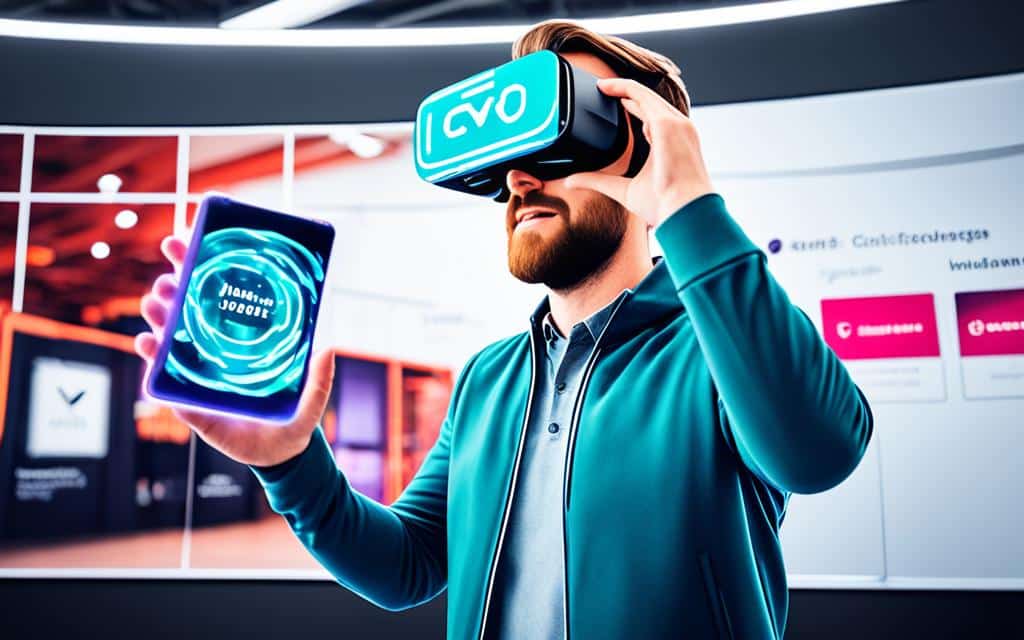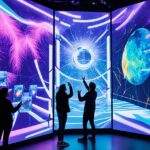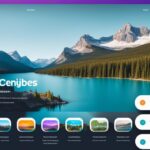Table of Contents
Augmented reality (AR) and virtual reality (VR) technologies are revolutionizing the way websites engage users and create immersive experiences. By integrating AR and VR into website development, businesses can enhance user engagement, provide interactive content, and drive conversion. In this article, we will explore the different ways AR and VR can be integrated into website development and provide tips for creating compelling AR/VR experiences.
AR and VR can be seamlessly integrated into website development to create engaging and immersive user experiences. AR can provide additional information or interactive features within a website, while VR can create fully immersive environments. Integrating AR and VR into website development requires specialized programming and design expertise, and there are frameworks and development tools available to simplify the process. It is important to define objectives, choose the right technology, design and create the AR/VR experience, integrate it into the website, and test and optimize the experience before launching and promoting it.
The Role of AR and VR in Website Development
AR and VR integration play a pivotal role in transforming website development into immersive and engaging experiences for users. By seamlessly incorporating augmented reality (AR) and virtual reality (VR) into the website development process, businesses can provide interactive features, informational overlays, and fully immersive environments.
AR allows websites to offer additional information or interactive elements that enhance user experiences. For example, an e-commerce website could utilize AR to allow customers to virtually try products before making a purchase.
“AR and VR integration play a pivotal role in transforming website development into immersive and engaging experiences for users.”
On the other hand, VR presents an opportunity to create fully immersive environments within websites, transporting users to virtual worlds or simulated experiences. This technology is particularly useful for industries like tourism, education, and gaming, where users can explore virtual destinations, engage in interactive learning experiences, or participate in immersive gaming environments.
Integrating AR and VR into Website Development
Integrating AR and VR into website development requires specialized programming and design skills. Fortunately, there are frameworks and development tools available that simplify the process. To successfully integrate AR and VR, website developers should follow a systematic approach:
- Define Objectives: Clearly outline the objectives for integrating AR and VR into the website. This could include enhancing user engagement, providing immersive experiences, or driving conversions.
- Select the Right Technology: Choose the appropriate AR and VR technologies that align with the defined objectives and project requirements. Consider factors such as compatibility, hardware limitations, and budget.
- Design and Create the AR/VR Experience: Utilize specialized design skills to create visually appealing and interactive AR and VR experiences. This may involve creating 3D models, designing user interfaces, and integrating interactive elements.
- Integrate into the Website: Seamlessly integrate the AR and VR experiences into the website, ensuring compatibility across different devices and browsers.
- Test and Optimize: Thoroughly test the AR and VR experiences to identify any issues or compatibility challenges. Optimize the experiences to ensure smooth performance and an engaging user experience.
Once the AR and VR experiences have been integrated, tested, and optimized, the website is ready to be launched and promoted to the target audience, offering a truly immersive and interactive user experience.
How to Use AR and VR in Website Development
When incorporating AR and VR technology into website development, it is essential to follow a systematic approach that encompasses defining objectives, selecting the appropriate technology, designing and creating the AR/VR experience, integrating it into the website, and thoroughly testing and optimizing the final product. These steps are crucial to ensure a seamless and immersive user experience.
To begin, clear objectives must be established. Whether the aim is to create a more immersive website experience, provide interactive content, or enhance user engagement and conversion, having well-defined goals sets the foundation for a successful AR and VR integration.
Next, it is vital to select the most suitable AR and VR technologies based on the defined objectives and budget. Various technologies are available, each offering unique features and capabilities. Choosing the right technology ensures that the desired objectives can be achieved effectively.
Designing and creating the AR/VR experience require specialized skills and expertise. Collaborating with experienced professionals in the field ensures a high-quality and engaging end product. With their guidance, the AR/VR elements can be seamlessly integrated into the website, enhancing its overall appeal and functionality.
Once the development phase is complete, extensive testing is necessary to guarantee compatibility across different devices and browsers. Optimizing the experience for optimum performance ensures that users can fully appreciate and interact with the AR and VR elements of the website.
After thorough testing and optimization, it’s time to launch and promote the AR/VR experience. Utilizing various channels such as social media, email marketing, and targeted advertisements helps generate awareness and attract the desired audience.
Overall, incorporating AR and VR technology into website development offers limitless opportunities to create immersive and interactive experiences. By following the outlined steps, businesses can effectively leverage these technologies to achieve their objectives, enhance user engagement, and create a truly memorable online presence.
Ways to Enhance Websites Using AR and VR Tech
AR and VR technologies offer exciting opportunities to enhance websites and create immersive user experiences. By integrating these technologies into website development, businesses can provide enhanced product visualization, interactive storytelling, virtual tours, and training and education experiences. Let’s explore how AR and VR can revolutionize website content:
Enhanced Product Visualization
AR and VR enable users to experience products in a more realistic and interactive way. Through augmented reality, users can visualize products in their own environment, allowing them to make informed purchasing decisions. For instance, furniture retailers can offer virtual try-on experiences, where customers can place virtual furniture pieces in their homes to see how they fit and look.
Interactive Storytelling
AR and VR can transform website storytelling by providing immersive and interactive experiences. Through 360-degree videos and virtual reality environments, websites can engage visitors in compelling narratives. Imagine a news website using VR to provide a 360-degree view of a breaking news event, or a travel blog offering virtual tours of exotic destinations, bringing stories to life in a captivating way.
Virtual Tours
Websites can leverage AR and VR technologies to offer virtual tours of physical locations. Museums, theme parks, and tourist attractions can create virtual experiences that allow users to explore and interact with their offerings from the comfort of their own homes. This brings a new level of engagement and education to visitors who may not have the opportunity to visit these locations in person.
Training and Education
AR and VR can revolutionize training and education by creating immersive learning experiences on websites. Users can engage in virtual simulations, practice skills, and receive interactive feedback, making the learning process more engaging and effective. Medical training programs, for example, can use VR to simulate surgeries and allow students to practice procedures in a safe environment.
| AR and VR Application | Benefits |
|---|---|
| Enhanced Product Visualization | Allows users to visualize products in their environment, leading to more informed purchasing decisions |
| Interactive Storytelling | Captivates and immerses website visitors in compelling narratives, making storytelling more impactful |
| Virtual Tours | Offers virtual exploration of physical locations, giving users a sense of place and providing an educational experience |
| Training and Education | Provides immersive learning experiences, allowing users to practice and acquire new skills in a virtual environment |
AR and VR technologies provide website developers with powerful tools to enhance user engagement and create unforgettable experiences. By leveraging these technologies, businesses can offer unique and interactive content that sets them apart from competitors, drives user satisfaction, and boosts conversion rates.
The Impact of VR and AR on Mobile App and Web Design
The integration of AR and VR technologies has revolutionized user experiences in mobile app design and web platforms. Augmented reality (AR) enhances the real-world environment by overlaying digital elements, while virtual reality (VR) creates entirely virtual environments. These immersive technologies offer a higher level of interactivity and engagement, transforming users from passive consumers to active participants.
When integrating AR and VR into design, it is crucial for designers to prioritize user experience and adopt a user-centric approach. By considering user behavior, needs, and pain points, designers can create intuitive and user-friendly interfaces that provide seamless interaction. Clear instructions, visual hierarchy, and simplicity are key elements in ensuring an immersive and enjoyable experience for users.
Furthermore, performance optimization and compatibility with different devices and browsers are vital considerations in AR and VR integration. Designers need to ensure that the AR and VR experiences are optimized for smooth performance, minimizing latency and loading time for a seamless and responsive user experience across various platforms.
“The integration of AR and VR technologies has transformed the way users interact with digital content,” says Sarah Thompson, a UX designer at a leading tech company. “By embracing these immersive technologies and designing with the user in mind, we can create truly captivating and meaningful experiences.”
Benefits of Integrating AR and VR into Mobile App and Web Design:
- Enhanced user engagement and interactivity
- Improved user experience and satisfaction
- Increased customer loyalty and retention
- Opportunity for innovative and immersive storytelling
- Realistic product visualization for e-commerce
- Interactive training and education experiences
| AR Integration | VR Integration |
|---|---|
| Enhances real-world environment | Creates entirely virtual environments |
| Overlay digital elements | Immersive storytelling experiences |
| Interactive product visualization | Virtual tours and simulated experiences |
| Augmented tour guides | Interactive gaming experiences |
“AR and VR technologies have revolutionized mobile app and web design, offering immersive experiences that engage users in new and exciting ways,” explains James Parker, a web designer at a renowned digital agency. “By integrating these technologies, we can create visually stunning and interactive interfaces that captivate users and drive business growth.”
Challenges in Integrating AR and VR into Mobile Apps and Web Platforms
Integrating AR and VR into mobile apps and web platforms presents several challenges that designers and developers need to address. These challenges include hardware limitations, motion sickness and disorientation, browser compatibility, and performance optimization.
Hardware Limitations
One of the key challenges in AR and VR integration is the varying hardware capabilities of mobile devices and web browsers. Not all devices or browsers support AR and VR technologies, which can limit the audience that can access these experiences. Designers must ensure that their AR and VR experiences are compatible with a wide range of devices and browsers to maximize accessibility.
Motion Sickness and Disorientation
When users immerse themselves in VR experiences, they may experience motion sickness and disorientation due to the disconnect between the virtual and physical worlds. To mitigate these issues, designers must minimize abrupt movements and provide smooth transitions to create a more comfortable and immersive experience for users.
Browser Compatibility
AR and VR experiences should work seamlessly across different web browsers and devices. Ensuring browser compatibility is crucial to provide a consistent and reliable user experience. Designers need to thoroughly test their AR and VR experiences on different browsers and devices to identify and resolve any compatibility issues that may arise.
Performance Optimization
Incorporating AR and VR technologies can significantly impact the performance of mobile apps and web platforms. Long loading times and high latency can disrupt the overall user experience. Designers and developers should collaborate closely to optimize performance by improving loading times, reducing latency, and optimizing graphics and animations to ensure a smooth and responsive user experience.
| Challenges | Solutions |
|---|---|
| Hardware Limitations | Ensure compatibility with a wide range of devices and browsers |
| Motion Sickness and Disorientation | Minimize abrupt movements and provide smooth transitions |
| Browser Compatibility | Thoroughly test on different browsers and devices to ensure compatibility |
| Performance Optimization | Collaborate with developers to optimize loading times and reduce latency |
By addressing these challenges, designers and developers can overcome the obstacles associated with integrating AR and VR into mobile apps and web platforms, allowing for the creation of immersive and engaging user experiences.
Use Cases of AR and VR Integration in Mobile Apps and Web Platforms
The integration of AR and VR technologies has opened up a world of possibilities across various industries. Let’s explore some of the key use cases where AR and VR integration has made a significant impact:
E-commerce and Retail
AR integration has revolutionized the e-commerce and retail sector, offering customers the ability to visualize products in their physical surroundings before making a purchase. This feature reduces the chances of product returns and increases customer satisfaction.
Education and Training
VR integration has transformed the field of education and training by providing interactive and immersive learning experiences. With VR, students can engage in virtual simulations and scenarios, enhancing their understanding and retention of complex subjects.
Tourism and Travel
AR applications in travel apps have enhanced the overall tourism and travel experiences. By providing augmented tour guides, users can explore destinations with additional information and interactive features, making their journeys more enriching and memorable.
Entertainment and Gaming
The entertainment and gaming industries have harnessed the power of both AR and VR technologies to create immersive and interactive gaming experiences. Players can now step into virtual worlds, interact with characters and objects, and have truly immersive gaming adventures.
Mobile App Design and Web Design
In the realm of mobile app design and web design, intuitive user interfaces, visual feedback, contextual design, performance optimization, and scalability are crucial considerations for creating remarkable AR and VR experiences. Providing seamless and captivating AR and VR interactions enhances user engagement and improves overall user satisfaction.
As we can see, the integration of AR and VR technologies has opened up new avenues for businesses and industries to deliver enhanced experiences for their users. By leveraging these technologies, businesses can drive engagement, increase customer satisfaction, and stand out in today’s competitive digital landscape.
/* Table */
| Industry | Use Cases |
|---|---|
| E-commerce and Retail | Visualization of products in physical space, reducing product returns |
| Education and Training | Interactive and immersive learning experiences |
| Tourism and Travel | Augmented tour guides for enhanced travel experiences |
| Entertainment and Gaming | Immersive and interactive gaming experiences |
| Mobile App Design and Web Design | Intuitive interfaces for captivating AR and VR interactions |
Conclusion
The integration of AR and VR into interactive web experiences has revolutionized user engagement and created immersive digital encounters. This seamless blend of real and virtual realities, empowered by AR/VR Integration, offers personalized immersion, enhanced collaboration, and limitless possibilities for the future of UX. As technology continues to advance at a rapid pace, AR and VR will play an increasingly significant role in shaping the way we interact with digital content and the world around us.
By embracing a user-centric design approach and carefully considering the challenges involved, designers can create captivating and seamless experiences that engage users in new and exciting ways. The future promises even more engaging, interactive, and personalized digital encounters as immersive technologies continue to evolve.
With AR/VR Integration, users can be transported to virtual worlds, explore lifelike environments, and interact with digital content in ways never before possible. The future of UX holds tremendous potential for personalized immersion, enabling individuals to tailor their experiences based on their preferences and needs. Enhanced collaboration is another significant aspect that AR and VR bring to the table, allowing users to work together remotely, regardless of their physical location.
The possibilities for AR and VR in web development are truly limitless, from e-commerce and education to entertainment and beyond. As businesses and designers adopt these technologies, they will unlock new dimensions of immersive experiences and shape the way we interact with digital content in ways we could only imagine. The future is bright, and the future is immersive.
FAQ
How can AR and VR technologies be integrated into website development?
AR and VR technologies can be seamlessly integrated into website development through specialized programming and design expertise. There are frameworks and development tools available to simplify the process.
What are the key steps to using AR and VR technology in website development?
The key steps to using AR and VR technology in website development include defining objectives, choosing the right technology, designing and creating the AR/VR experience, integrating it into the website, and testing and optimizing the experience before launching and promoting it.
What are the different ways AR and VR can enhance websites?
AR and VR can enhance websites by providing more realistic and interactive product visualization, creating immersive and interactive storytelling experiences, offering virtual tours of physical locations, and facilitating training and education experiences.
What is the role of AR and VR in mobile app and web design?
The integration of AR and VR into mobile app and web design revolutionizes user experiences by enhancing the real-world environment with digital elements and creating fully virtual environments, increasing interactivity and engagement.
What are the challenges in integrating AR and VR into mobile apps and web platforms?
Challenges in integrating AR and VR include limited hardware support, potential motion sickness and disorientation in VR experiences, browser compatibility, and the need for performance optimization to ensure smooth and responsive user experiences.
In which industries can AR and VR integration be applied?
AR and VR integration can be applied in various industries, including e-commerce and retail for product visualization, education and training for immersive learning experiences, tourism and travel for augmented tours, and entertainment and gaming for interactive gaming experiences.













